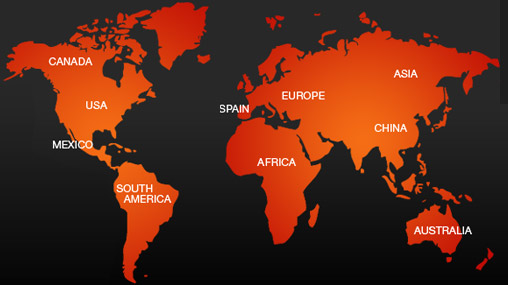- Home About RM Minerals
- Virtual Photo Museum Blog RM Contact
- Microscopy and instruments How to Buy Disclaimer
Copyright 2010-2025
www.rosellminerals.com



Pyromorphite specimens from the San Andrés mine in Espiel, Córdoba, have been known since the first half of the 20th century. At the beginning of the 80s of this past century several quality specimens were recovered from the mine. This specimen, due to the date on the label of the J. Astor collection (Barcelona), can be dated to this period. The specimen shows several pyromorphite crystals, of good size, brilliant, translucent, thick and with shapes of the hexagonal barrel shaped prism, with the characteristic color between green to yellowish-green. They fill a vug in the goethite matrix. A Spanish classic.
Rich specimen formed by several aggregates of thick pseudo-hexagonal baryte crystals, with luster, white to yellowish colour, that stand out on a matrix of goethite. The baryte specimens from this Spanish mine are highly prized by collectors. This specimen belongs from the former J. Astor collection (Barcelona). With old labels.
Molybdenite specimens from Inca del Oro are very difficult to find in the market and more with defined crystals. This sample shows a very well defined, bright and well-disposed hexagonal crystal of molybdenite on the matrix. A unique opportunity to include to your collection a very representative and fine specimen for the species. It belongs from the former J. Astor collection (Barcelona). The locality of Inca del Oro is located between the Chilean provinces of Copiapó and Chañaral.
Very interesting specimen of opal with opalescence of violet, blue, green colors that fill the fissures of a xylopal. Very aesthetic due to its arrangement in veins, contrasting with the sienna warm colors of fossil wood. This Australian locality is known for opalized pineapples. Specimens from this locality are difficult to find.
A classic banded opal from Australia, with violet, green, blue colors. With a good exposed surface showing opalescence. It comes from the A. Trigo collection.
Very glassy opal specimen, with excellent transparency and yellowish bands. From an unusual area of Russia for this variety of quartz. It was acquired by A. Trigo (Mataró) in 1983, in Expominer Mineral Show (Barcelona).
Druse of quartz crystals, milky to hyaline at the tips, with a certain reddish hue. It comes from a Moroccan locality unknown in collections, located in the Boulemane area, north of Aouli. Formed in volcanic rocks.
An extremely glassy opal specimen, transparent to translucent, with bluish to golden tones. An excellent specimen of opal from this classic American locality. It shows some fluorescence under ultraviolet (LW) light. An old piece from the A. Trigo collection (Mataró).
Group of very sharp cubic crystals of fluorite, very transparent, colorless, brilliant and in staggered growth. It presents certain very curious inclusions. Minos matrix of galena. Very aestetic. From the former Trigo Collection (Mataró).
Groups of aggregates of rhodochrosite crystals, of a delicate pink color, brilliant. They are accompanied by colorless aggregates of small quartz crystals. Very aesthetic.
Group of very acute scalenohedral calcite crystals, well defined and with a brown colour due to inclusions. Thanks to some of these crystals that show exfoliation, we can observe that it has been formed in the final stages of their growth. From the A. Trigo collection (Mataró).
Good size sample of the meteoric impact that took place aproximately 49,000 years ago in this remote area of Arizona. The impact crater stands out, where more than 30 tons of material have been collected since was discovered in 1891. It is a metallic, iron-nickel meteorite, classified as coarse octahedrite. Contains taenite (Fe, Ni) and mostly iron, kamacite variety (Fe, Ni). Weight: 23 grams.
An interesting piece has gone back into the old work at the classic Choix locality and is pulling out some first-class smithsonites of blue, lavender and pink. From the collection of A. Trigo (Mataró).
Elongated single crystal of orange-pink childrenite without matrix. Transparent to translucent, with brilliance and defined terminal faces and altered prism.Very unusual for the species. From the former A. Trigo collection (Mataró).
Globular aggregate of good size of smithsonite crystals. Very brilliant, translucent and with some goethite as a matrix. From this classic Mexican mine. It belongs from the A. Trigo Collection (Mataró).
Glendonite is the name given to the pseudomorphic calcite after ikaite. Ikaite, a hexahydrated calcium carbonate, was first observed in nature in the 1960s, at the seabed of the Ikka Fjord in Greenland. There, it precipitates due to the mixture of cold water submarine springs (3°C) rich in carbonates with seawater. Ikaite deposits are not usually found due to its poor stability, however, sometimes the rapid conversion of ikaite to calcite and water results in the generation of pseudomorphic calcite aggregates in the shape of the ikaite crystal (so-called glendonites). These calcite pseudomorphs directly replace ikaite above 4ºC.
Good sized fluorite crystal from this classic North American mine. It shows the cube shape with staggered growths on one edge, along with polysynthetic growths on the faces. Translucent to transparent, bright and with a violet tone that shows geometric color zoning, more intense on the edges. With a minor "matrix" of sphalerite.
Aesthetic specimen of calcite crystals that form this semi-globular aggregate, with luster. It is accompanied by a small matrix with quartz and chalcopyrite crystals. A classic from the Romanian mine of Boldut; from the A. Trigo collection (Mataró). It shows an intense fluorescence under LW-UV light.
Hemispherical aggregate of smithsonite crystals, of good size, luster and with a very curious orange-brown color. On the label of the A. Trigo (Mataró) collection it indicates that he bought this specimen from a Moroccan dealer (1989) as "tornuisite", a term for which we have not found references, unless it was wrongly confused with "tarnowizite". Touissit specimens of globular smithsonite are known but rare.
Globular aggregates of prismatic natrolite crystals, with well defined terminal faces. It comes from a locality well known for its zeolites. Nowadays this Cape Grim area is restricted access due to wind turbines field. From the former A. Trigo Collection (Mataró).
Globular aggregate of prismatic natrolite crystals, with well defined terminal faces. It is disposed very aerially on the matrix. Specimens on matrix are unusual. It comes from a locality well known for its zeolites. Nowadays this Cape Grim area is restricted access due to wind turbines field. From the former J. Astor Collection (Barcelona).
Group of cubic fluorite crystals, with good brilliance, transparence and a very characteristic green color. From this classic Moroccan mines. With the label of the former collection Trigo (Mataró).
These specimens of manganite partially replaced pyrolusite, come from a locality not yet described in the mineralogical bibliography. This deposit is located in the province of Boulemane, in the Fez-Meknés region, about ten kilometers from the well-known Aouli mines. It is a formation very similar to that of Imini (near Ouarzazate). These manganese deposits, both in Imini and in the Boulemane area, were formed in a karst system. Associated with shallow marine dolomites of the Cretaceous age and that currently form sub-horizontal mantles cutted by erosion, overlaping areas of volcanic rocks. Manganese minerals are found in dolomite breccia and ferruginous clays. We have carried out X-ray diffraction studies showing us the presence of both species: manganite and pyrolusite.
These specimens of manganite partially replaced pyrolusite, come from a locality not yet described in the mineralogical bibliography. This deposit is located in the province of Boulemane, in the Fez-Meknés region, about ten kilometers from the well-known Aouli mines. It is a formation very similar to that of Imini (near Ouarzazate). These manganese deposits, both in Imini and in the Boulemane area, were formed in a karst system. Associated with shallow marine dolomites of the Cretaceous age and that currently form sub-horizontal mantles cutted by erosion, overlaping areas of volcanic rocks. Manganese minerals are found in dolomite breccia and ferruginous clays. We have carried out X-ray diffraction studies showing us the presence of both species: manganite and pyrolusite.
These specimens of manganite partially replaced pyrolusite, come from a locality not yet described in the mineralogical bibliography. This deposit is located in the province of Boulemane, in the Fez-Meknés region, about ten kilometers from the well-known Aouli mines. It is a formation very similar to that of Imini (near Ouarzazate). These manganese deposits, both in Imini and in the Boulemane area, were formed in a karst system. Associated with shallow marine dolomites of the Cretaceous age and that currently form sub-horizontal mantles cutted by erosion, overlaping areas of volcanic rocks. Manganese minerals are found in dolomite breccia and ferruginous clays. We have carried out X-ray diffraction studies showing us the presence of both species: manganite and pyrolusite.
